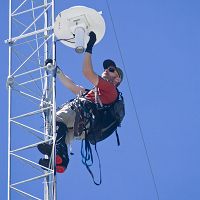Meadows et al., 2009
Soil moisture response to snowmelt and rainfall across elevation, aspect and canopy cover in the Southern Sierra Nevada
Meadows, M.W., Bales, R.C., Hopmans, J.W., Hartsough, P.C., O'Geen, A.T., Kirchner, P.B. (2009)
Fall meeting, American Geophysical Union, December 2009. 90(52). Abstract H33A-0856
-
Sierra, STAFF
-
Sierra, INVESTIGATOR
-
Sierra, COLLABORATOR
-
Sierra, INVESTIGATOR
-
Sierra, INVESTIGATOR
-
Sierra, GRAD STUDENT
Abstract
A water-balance instrument cluster that includes 27 snow-depth measurements and vertical profiles of soil temperature and volumetric water content was deployed in summer 2007 at the Southern Sierra Critical Zone Observatory (CZO), at an elevation of 1,600-2,000 m. The CZO is co-located with the Kings River Experimental Watersheds, a U.S. Forest Service integrated watershed research site. Instruments were deployed to capture north- and south-facing aspects, as well as differences in canopy cover and tree species. Data include snow depth, soil moisture, and temperature for two years. Snow on south-facing slopes melted before snow on north-facing slopes, resulting in drier, warmer soils after spring snowmelt. In total, soil moisture and temperature probes (Echo TM, Decagon Devices, Inc) were installed at 27 different locations and at 4 soil depths. Soils dried out rapidly in the week following the end of snowmelt. Whereas soil moisture was very responsive to snow melting in the early spring at all locations, soil moisture responses to multi-day summer rain events are evident at shallow depths. Soils are weakly developed (Inceptisols and Entisols) formed from granite residuum and colluvium. Differences include a greater degree of rubification in B horizons in soils positioned on lower slope angles, greater litter thicknesses under tree canopy and on north-facing slopes, and very coarse sand textures associated with variability in parent material. Litter thickness may have influenced measured volumetric water content, as values were consistently lower at shallower than deeper depths. Differences in volumetric water content between sites at the same aspect may also depend on soil characteristics such as the coarse sand content. Wet-season volumetric water content in compact saprolite (weathered bedrock) was typically 12-15%, versus 22-30% for mineral soil in the same pit.Macropores, observed at some sites during installation of the soil moisture probes may have influenced relative values of soil temperature and water content. For example temperature anomalies 5°C higher than daily peaks at the 60-cm depth may be a sign of recent burrowing activity by mammals.
Citation
Meadows, M.W., Bales, R.C., Hopmans, J.W., Hartsough, P.C., O'Geen, A.T., Kirchner, P.B. (2009): Soil moisture response to snowmelt and rainfall across elevation, aspect and canopy cover in the Southern Sierra Nevada . Fall meeting, American Geophysical Union, December 2009. 90(52). Abstract H33A-0856.
Explore Further






